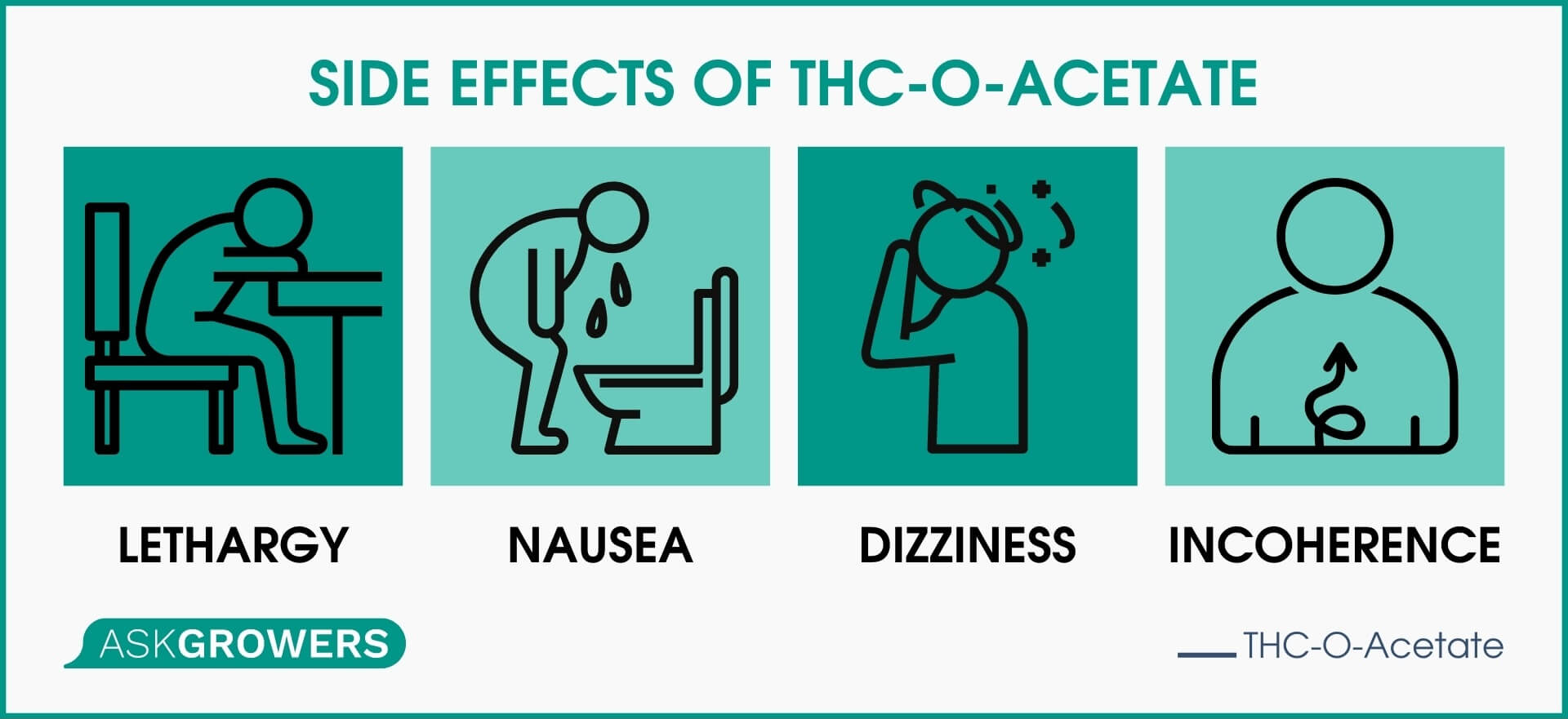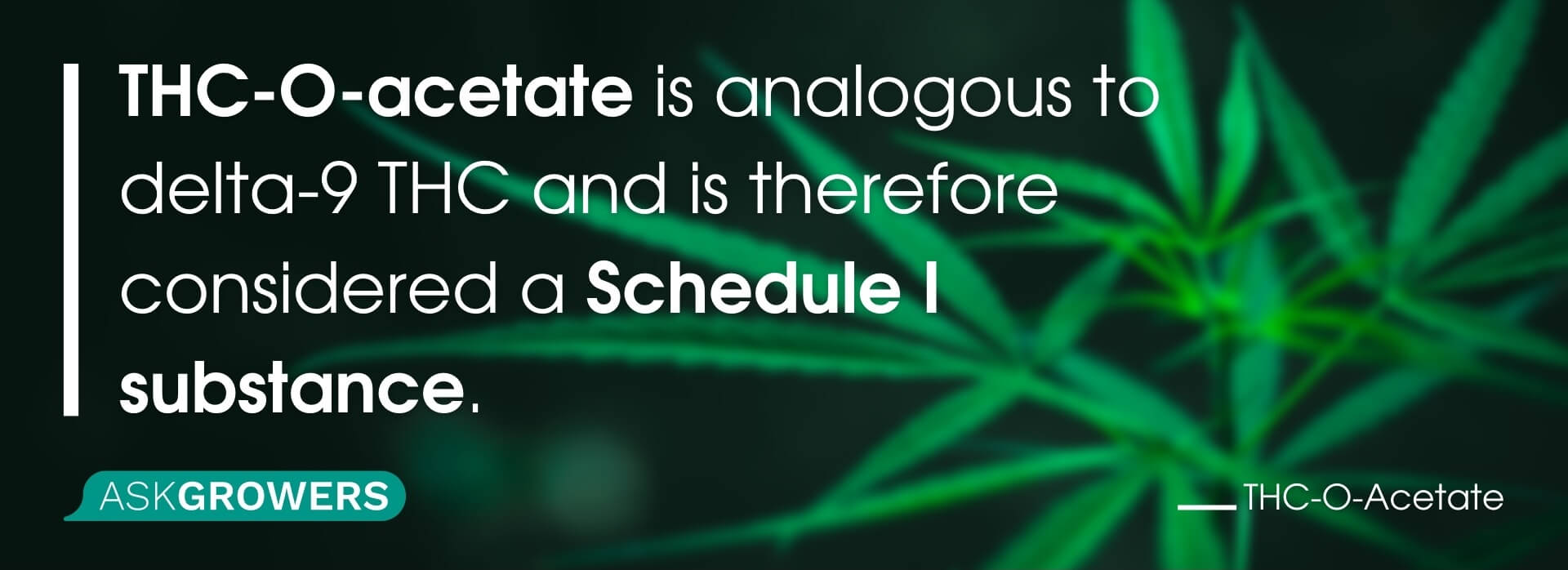
What is THC-O and why is this psychedelic cannabinoid 3x stronger than THC?
This article originally appeared on AskGrowers.com and has been republished unedited with permission.
Even for the layperson with a decent working knowledge of cannabis, THC-O (aka THC acetate or THC-O-acetate) is a fairly unknown non-natural cannabinoid. Unlike the more visible CBD or even THC, you won’t see articles about it in health magazines or see ads for it pop up on social media.
It’s been under the radar for years, and now there’s a growing discussion surrounding THC-O. This is for two reasons: its potency and its accessibility. THC-O has been found to be about three times more potent than regular THC. And because the law has yet to catch up with its existence, it can be accessed by anyone living in a state where conventional THC is illegal.
What is THC-O-Acetate and why is there so much debate about it?
THC-O is artificially synthesized from the precursor to traditional THC, called tetrahydrocannabinolic acid, or THCA. The process used to create THC-O preserves the basic structure of THCA but adds an acetate group.
TCH-O is what is known as a “prodrug,” which simply means that it only becomes active in the body after the liver has metabolized it. Acetylated THC is much more potent than its naturally derived counterparts as it can more easily cross lipid-sensitive barriers in the brain and digestive tract. Once metabolized, what remains in the body is a more bioavailable delta-9-THC compound.
Processed as an odorless and tasteless compound, THC-O is not water soluble. It appears in the market in the form of vapes, edibles like gummies, tinctures, and other products. THC-O products are similar to THC products, only with greater potency.
A Brief History of THC-O-Acetate
THC-O wasn’t really in the public eye until recent years, but it was investigated by the US military as early as 1949. In the 1970s, DEA agents raided a Florida lab synthesizing THC-O. However, since there seemed to be no real market for it, the FDA didn’t investigate the compound further. The War on Drugs has apparently passed by this one.
In 2018, the United States Congress passed legislation allowing the cultivation and production of hemp. Since THC-O can be synthesized from hemp, an underground marketplace began to grow. With the laws surrounding the compound being vague and unclear, THC-O has started to gain popularity, particularly in states where traditional cannabis remains illegal.
how is it done?
Like traditional THC, THC-O is synthesized from hemp. It is synthetically altered to alter its chemical structure. The process begins with THCA, the compound from which all other forms of THC are derived. Traditional Δ9 THC and Δ8 THC are decarboxylated (a chemical process that removes a carbon atom from the carbon chain) through the application of heat. However, THC-O is made by taking the raw THCA and processing it with sulfuric acid and acetic anhydride before heating it, which dramatically changes its molecular structure.
This is an extremely volatile chemical process, and under no circumstances should anyone attempt to make THC-O in a home lab. Processing at home is not only extremely dangerous, but also probably ineffective. THC-O requires very specific processing parameters, and a layman would not be able to create a potent product.
What do we know about the effects of THC-O?
THC-O is an extremely psychoactive form of THC. It offers a high that is around 3x stronger than regular marijuana. THC-O-Acetate is mildly hallucinogenic, earning it the nickname “the psychedelic cannabinoid”. Because of this, it’s good to note that it’s best to be cautious when consuming. It is safer for those who are already used to the effects of cannabis. The effects at higher doses have been compared to those of mescaline, LSD, or “magic mushrooms.” Users can feel extremely “heavy” and unable to move. Lower doses are comparable to the typical delta-9 THC variant.
Due to the breakdown of THC-O in the body, the high does not kick in for about 20-30 minutes after consumption (it has to be metabolized in the liver first).

Some side effects of THC-O-Acetate are:
- Extreme lethargy/sedation
- nausea or vomiting
- dizziness
- seizures
- Inability to act and/or incoherence
These negative side effects are more likely to occur at higher doses. Here are the recommended dosages.
- Effect threshold: vaporized or smoked 0.5 mg, orally 3 mg
- Psychoactive Standard: vaporized or smoked 1-3 mg, orally 3-10 mg
- Psychedelic effects: more than 5 mg smoked, orally 10 or more mg
For those trying to cheat the drug test, THC-O will not help as it leaves the body as a more potent form of delta-9-THC after being metabolized by the liver. This excretion is recorded in a THC drug test.
Is THC-O safe to consume?
There isn’t enough research on TCH-O to determine if it’s safe for human consumption. Since it’s only recently emerged from the underground, there’s certainly some risk involved in its use. Although there has never been a fatality from an overdose while using THC-O, there are a few things to keep in mind when consuming it.
Vapes containing vitamin E acetate have caused a virulent form of the lung disease called lipoid pneumonia in some users. While there isn’t enough research to show a similar effect with THC acetate, some experts suspect there might be a similar effect when ingested through vape carts.
RELATED: What Is THC-O, and Is It Legal?
Another possible problem is a collision with adulterated products. This is a highly unregulated synthetic drug. Therefore, there is a good chance of receiving an impure, contaminated, or downright dangerous product.
Finally, since this prodrug is so incredibly powerful, it’s important to go slow. Start with a very small, minimal dose and may not increase until your body adjusts to the effects.
THC-O vs THC, Delta-9 THC vs Delta-8 THC
The most common form of the THC derivative is Delta 9 – this is present actively in marijuana and in smaller amounts in hemp. The Delta 8 is another popular iteration that occurs naturally when Delta 9 collapses, but it can also be created synthetically. Here’s a quick breakdown of each THC compound.
Delta 9 THC
This form of THC occurs naturally. Its average concentration in marijuana is around 15-20%. Primary health benefits include analgesic (pain relieving) properties and anticonvulsant properties. The main target receptors include cannabinoid receptors 1 and 2 (CB1 and CB2). It has a high psychoactivity rate and costs $0.07 to $0.13 per mg.
Delta 8 THC
This form of THC is naturally derived from Delta 9. It has a 1% concentration in marijuana. Primary health benefits include sleep support and calming properties for anxiety. Target receptors include CB1 and CB2. It has a moderate psychoactivity rate and costs $0.06 to $0.12 per mg.
Legal situation and forecasts
The legality of THC-O-Acetate can be a bit tricky to figure out. It is not listed as a banned substance anywhere except in the UK and New Zealand. However, THC acetate is an analogue of delta-9-THC, which is listed as a Schedule 1 drug. In the US, that means it would likely be classified as a Schedule 1 drug under the 1986 bill, the Federal Analogue Act. Again, it’s not explicitly stated, but would fall into that category by default.

In Canada, this prodrug is not banned. There are also no laws that could categorize it this way, but it is very difficult to get THC-O in Canada.
Since there is a requirement in the US to classify it as a Schedule 1 drug, it is likely that it will become a federally banned substance in the future. Already, state and federal laws are scrambling to catch up with a growing market. There are 18 states that have legalized Delta 9, and THC-O could catch on in those states. As more states legalize THC, it may follow by default.
Is it worth a try?
For inquisitive stoners, trying out a new substance that is 300% stronger than THC is an extremely welcome experience. However, we urge you to explore new psychedelic horizons with caution as THC-O is a prodrug. This means that the chemical must first be metabolized in the body. Depending on the overall tolerance, the process can take 30 minutes, sometimes longer. This is potentially dangerous as an unwary smoker could think the dose was too low, which could lead to an overdose.
RELATED: What’s It Like Smoking THC-O Dominant Bud?
However, therapeutic use of THC-O makes more sense than casual recreation. There are known cases of cannabis patients consuming over 1,000 mg of THC daily to help them manage their debilitating, debilitating, and even fatal chronic conditions. For those therapeutic users who have a high cannabinoid tolerance, THC-O is worth trying. The form of edible tinctures is the most convenient form of consumption that can fit into any lifestyle.
As with any medicine, whether you decide to try it for yourself is a matter of personal preference and choice. However, there are a few things to consider and check before making this decision.
First, remember that THC-O is extremely powerful. More potent than any other form of THC available. It is a prodrug, meaning it is metabolized before being processed at the cannabinoid receptor sites. If you do decide to give it a try, start slow and slowly increase your dosage. Recommended THC-O dosages are the following:
- Beginner (low tolerance): 3mg-10mg per application
- Intermediate (medium tolerance): 10mg-25mg per application
- Advanced (high tolerance): 25mg-50mg+ per application
MEMORY: Make sure your body can handle the effects before moving on to the next dose level!
One more thing. Under no circumstances should you attempt to process this drug yourself. It’s both difficult to do right and extremely dangerous when done wrong. Incorrect processing can not only cause volatile chemical reactions, but you can also end up with a compromised product. If you decide to consume THC-O, only buy it from a source you trust.
references
https://www.ncbi.nlm.nih.gov/articles/PMC-3570572/
https://www.nap.edu/read/9136/chapter/5
https://books.google.pt/books-id=_tVJAQAAIAAJ&dq-marijuana+chemistry&q=&redir_esc=y
https://pubmed.ncbi.nlm.nih.gov/29982176/
https://www.deadiversion.usdoj.gov/21-cfr/21usc/813.htm

Post a comment: